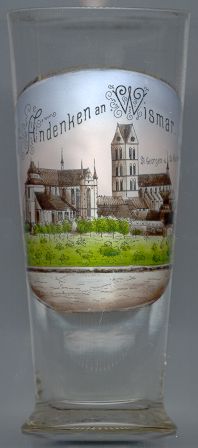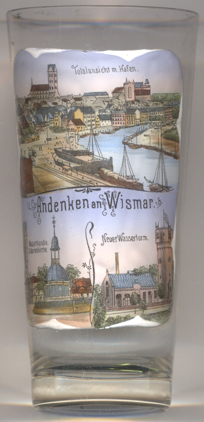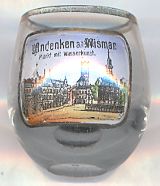

|
| DEUTSCHLAND | GERMANY |
| Bundesland: Mecklenburg-Vorpommern | Mecklenburg-West Pomerania |
| Landkreis: Nordwestmecklenburg |
 Wismar, situated at the Wismar Bay of the Baltic Sea, was first mentioned in 1229. Its town charter,
which is based on that of Lübeck, was confirmed in 1266.
From 1256 until 1358, Wismar was the residence of the princes of Mecklenburg.
Wismar became a member of the Hanse federation of trading towns in 1358.
In 1555 it became part of Mecklenburg-Schwerin.
During the Thirty Years' War, Wismar was occupied by Swedish troops in 1632. After the war, in 1648, Wismar became part of Sweden.
After 1680, the town became Europe's largest fortress, with 18 bastions, 9 ravelins and 2 citadels, armed by 700 canons.
When three towers that were used for the storage of gunpowder blew up in 1699, large parts of the town were destroyed.
During the Nordic War, the Danish ordered the fortress to be demolished in 1717.
During the Seven Years' War, Wismar was conquered by Prussia in 1757. In 1803, Wismar was pawned to the Duchy (since 1815 Grand Duchy) of Mecklenburg-Schwerin
for 100 years. In 1903, Sweden renounced of its rights and Wismar became integral part of of the Grand Duchy.
Although large parts of the town were destroyed in 1945 and further destructions followed in the 1960s, the old town of Wismar,
together with that of Stralsund, was listed as a World Cultural Heritage by the UNESCO in 2002
(see also list of other UNESCO heritage sites).
After the re-unification of Germany in 1990, the prefix 'Hansestadt' was again added to the city's name.
Wismar, situated at the Wismar Bay of the Baltic Sea, was first mentioned in 1229. Its town charter,
which is based on that of Lübeck, was confirmed in 1266.
From 1256 until 1358, Wismar was the residence of the princes of Mecklenburg.
Wismar became a member of the Hanse federation of trading towns in 1358.
In 1555 it became part of Mecklenburg-Schwerin.
During the Thirty Years' War, Wismar was occupied by Swedish troops in 1632. After the war, in 1648, Wismar became part of Sweden.
After 1680, the town became Europe's largest fortress, with 18 bastions, 9 ravelins and 2 citadels, armed by 700 canons.
When three towers that were used for the storage of gunpowder blew up in 1699, large parts of the town were destroyed.
During the Nordic War, the Danish ordered the fortress to be demolished in 1717.
During the Seven Years' War, Wismar was conquered by Prussia in 1757. In 1803, Wismar was pawned to the Duchy (since 1815 Grand Duchy) of Mecklenburg-Schwerin
for 100 years. In 1903, Sweden renounced of its rights and Wismar became integral part of of the Grand Duchy.
Although large parts of the town were destroyed in 1945 and further destructions followed in the 1960s, the old town of Wismar,
together with that of Stralsund, was listed as a World Cultural Heritage by the UNESCO in 2002
(see also list of other UNESCO heritage sites).
After the re-unification of Germany in 1990, the prefix 'Hansestadt' was again added to the city's name.
The  parish church Sankt Marien [right] was first mentioned in 1250.
This first, wooden, church was replaced by a brick church in about 1260–1280. Finally, the church was rebuilt
as a monumental basilica; the construction of this church lasted from 1339 until 1508.
In 1945, the church was severely damaged, and the ruins were finally blown up in 1960.
The only part of the church remaining today is the tower (80 m high), one of the landmarks of Wismar.
parish church Sankt Marien [right] was first mentioned in 1250.
This first, wooden, church was replaced by a brick church in about 1260–1280. Finally, the church was rebuilt
as a monumental basilica; the construction of this church lasted from 1339 until 1508.
In 1945, the church was severely damaged, and the ruins were finally blown up in 1960.
The only part of the church remaining today is the tower (80 m high), one of the landmarks of Wismar.
The Gothic  Sankt-Georgen-Kirche [left] was begun in 1295.
The church was intended to be one of the largest churches in Northern Germany. However, shortness of money prevented the
completion of the tower of the church. Only the lower parts up until the height of the roof of the nave were completed.
A bomb raid in April 1945 caused severe damages. For decades, the ruins of the church were neglected, and finally the north gable
collapsed in 1990. After the reunification of Germany it was decided to reconstruct the church until about 2010.
Sankt-Georgen-Kirche [left] was begun in 1295.
The church was intended to be one of the largest churches in Northern Germany. However, shortness of money prevented the
completion of the tower of the church. Only the lower parts up until the height of the roof of the nave were completed.
A bomb raid in April 1945 caused severe damages. For decades, the ruins of the church were neglected, and finally the north gable
collapsed in 1990. After the reunification of Germany it was decided to reconstruct the church until about 2010.

 The
The  Wasserkunst in the centre of the market square [left, no. 3135:bottom left, and right, no. 2466]
was created in 1602 by the Philipp Brandin from Utrecht. The first, wooden, fountain in this location had been built in 1563.
Wasserkunst in the centre of the market square [left, no. 3135:bottom left, and right, no. 2466]
was created in 1602 by the Philipp Brandin from Utrecht. The first, wooden, fountain in this location had been built in 1563.
The bottom right picture on glass no. 3135 [left] shows a view of the
 new watertower
new watertower
[https://de.wikipedia.org/wiki/Wismar;
https://de.wikipedia.org/wiki/Wasserkunst_Wismar;
https://de.wikipedia.org/wiki/Wasserturm_Wismar]
![[scale]](lineal.jpg)